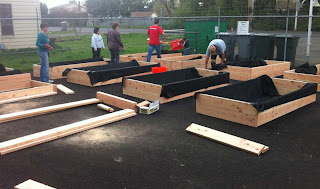 |
| Lettuce grown at BPMS last year |
What to do in the dreary winter:
- Pour over seed and plant catalogs, making long lists of new things to try
- Watch Garden Shows whenever you can
- Ponder how you will do things differently this year
- Make a diagram of your garden and plan your rotations
- Think about which way the sun travels so you don't shade your tomatoes with the corn
- Get your set up ready for starting your tomato and pepper seeds in late February
- Renew your plot at Baker Prairie Middle School Community Garden!
John Colvett is now asking people if they are keeping their plots for this coming summer. There is a waiting list this year and he is wanting to get a head start on the filling of plots. Don't let all the work you've done on that soil go to waste!
If you are wanting a garden plot let him know, just give John Colvett a shout! You can contact him through BPMS or through Canby Community Garden Association (canby community garden@ gmail)(no spaces).
 |
| Peas can be gently planted in late February. Just poke a hole in the much and pop in a seed. |
It is no good working the soil while it is wet. You will just make your clay soil into cement. Rubbing, digging and roto-tilling will line up the little plates in the clay and create a rock hard mass when the clay dries out.
The best solution for our Pacific Northwest clay soil is the addition of organic matter- compost, ground up leaves and the like. The organic matter spaces out the clay plates and keeps your soil holding just enough water for the plants and draining out any extra.
Clay soil isn't all bad! It has a higher amount of nutrients for plants than sandy soil.
You can fortify your organic matter without all the work AND head off spring weeds by mulching now with leaves or compost.
If you are planning on using straw, do yourself a favor and prepare the straw by watering down the bails (or leave them in the rain) and let them sit for a month or two. Have them sitting next to where you will use them because they become very heavy.
This will sprout all the weed and wheat seeds that are in the bail (and there are a lot of them) and then they will be trapped in the bail and die.
Many gardeners see straw in other gardens and don't realize that it has seeds in it. If you spread straw out fresh, you are just planting those seeds and will have to weed them later.
After the bail is wet for a while you can safely spread it around in your garden without adding more weeds. And it does make a fantastic mulch.
 |
Early spring brings yummy Asparagus!
|

















































